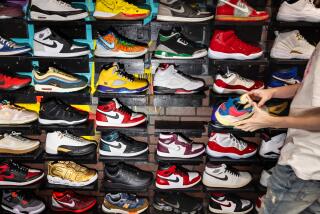DEAD SHOES WALKING
- Share via
I know it’s time to buy new running shoes when an old ankle injury that seldom bothers me begins to send brief flashes of dull pain. Typically, this occurs every six months, when I’ve run about 400 miles in the shoes. Even though the outsides usually still look pretty good, I’ve learned that shelling out the bucks for a new pair makes a critical difference in my health and enjoyment of the sport. Because with new shoes, the pain disappears.
Yet many people don’t recognize that discomfort in their legs, feet and back can come from working out in worn-out shoes.
“It’s a [leading] culprit when people start feeling aches and pains,” says Dr. Carol Frey, an orthopedic surgeon and director of the Foot and Ankle Center at Orthopedic Hospital in Los Angeles. “Fifty percent of a shoe’s shock-absorbing capacity is gone at 300 miles of running or walking or 300 hours of aerobics class. Eighty percent is gone at 500 miles or 500 hours,” she says.
Since this breakdown occurs in a nearly hidden part of the shoe called the midsole, people are often unaware that their shoes are dead. The midsole is the slice of cushioning material sandwiched between the outsole and the upper. Made of a synthetic rubber compound, the midsole also may include added impact reducers such as Nike’s Air or Asics’ Gel. Its function is to provide stability and shock absorption, and every step you take dulls its effectiveness.
The life of an athletic shoe varies depending on the sport and the wearer, says J.D. Denton, owner of Fleet Feet Sports in Davis, Calif., who answers shoe questions from runners around the world over the Internet. “The average person should be able to get 400 to 600 healthy miles to a pair of running shoes,” he says. But “heavier people are harder on shoes, as are people with less-efficient biomechanics.”
Running tends to be tough on shoes since it’s usually done on asphalt, which “chews up shoes,” Denton notes. Also, unlike court sports that involve varied motions, such as jumping, turning and sprinting, running is an activity that puts the same pattern of wear on the shoe over and over.
*
To extend the life of your shoes, air them out after use by pulling out the insoles, stuffing them with newspaper or paper towels and placing them in a well-ventilated area away from heat. Never leave shoes in the sun or a hot car or toss them in the washing machine. And don’t make the common mistake of trying to resuscitate dead shoes with new insoles. “Insoles are designed to adjust the support,” Denton says, “not to revive a shoe that’s already dead.”
Denying shoe death comes in part because they’re so pricey. The average cost of a pair of fitness walking shoes is $55, according to the National Sporting Goods Assn. Running shoes average $60 and basketball shoes, $68.
But the tendency to hang on to athletic shoes too long comes not just because we’re being cheap. “People are constantly adapting to their shoes and don’t realize how worn they’ve become,” says Tom Brunick, director of the Athlete’s Foot WearTest Center at North Central College in Naperville, Ill., and footwear editor at Walking magazine. Since many people won’t keep a log of miles or hours that they’ve worn their shoes, he recommends this strategy to diagnose shoe death:
About a month after you buy new athletic shoes, purchase a second pair of the same or similar shoes. Then, once a week, wear the newer shoes. This will let you compare how a good, cushioned midsole feels, so you’ll know when the old pair is dead. A month after you switch to the newer pair, buy brand new shoes and start the process over.
Another method, from orthopedist Frey: Place the shoes on a counter and examine them from behind. If they roll in or out too much, they’re deformed and should be replaced.
“Athletic shoes should protect you from injury and enhance your performance,” she says. “Once they’re worn down, they no longer act as athletic shoes, but are mere foot coverings. Save them for gardening.”
For expert advice on athletic shoes, e-mail J.D. Denton at JDShoeguyaol.com or sign on to the Athlete’s Foot’s Web site: https://www.Theathletesfoot.com.
(BEGIN TEXT OF INFOBOX / INFOGRAPHIC)
RESOURCES
For free pamphlets on athletic shoes, call the American Academy of Orthopaedic Surgeons at (800) 824-BONES ([800] 824-2663); the Athlete’s Foot at (800) 353-FOOT; or send a self-addressed, stamped envelope to American Academy of Podiatric Sports Medicine, 1729 Glastonberry Road, Potomac, MD 20854.
(BEGIN TEXT OF INFOBOX / INFOGRAPHIC)
Shoes to Choose?
If your walking shoes have walked their last mile, heaved their last breath and smell downright fun-KAY, perhaps you should head over to the local newsstand and check out Walking magazine’s “New Shoe Buyer’s Guide” in the March / April issue.
Staff writers--and walking experts--Tracy Teare and Tom Brunick rate more than 30 pairs of shoes ranging in price from $50 to $100.
Among the editors’ choices: New Balance 840, Nike Air Provider RW, Adidas Solo II, Reebok Rejuvenation.
For additional information on Walking magazine, call (800) 266-3312.


